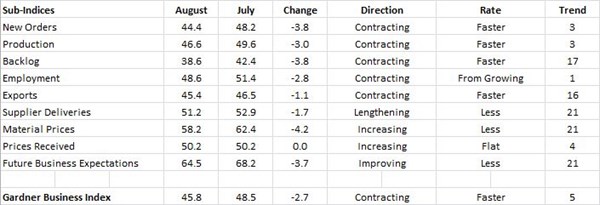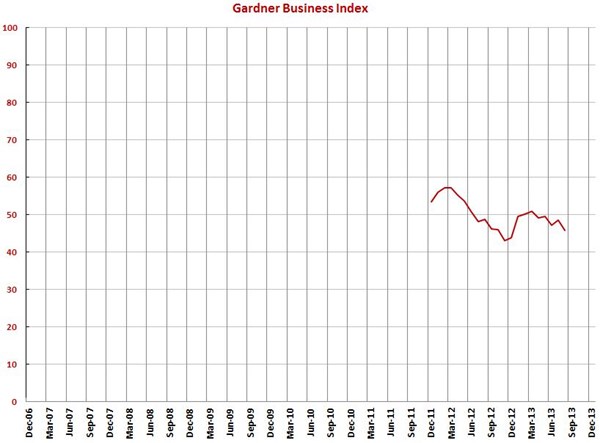August GBI at 45.8 –Contraction Enters 5th Month
This is durable goods manufacturing’s fastest rate of contraction since December 2012. Manufacturing contracted faster for most of the second half of 2012 before leveling off early in 2013. However, the durable goods manufacturing industry once again has been contracting faster for most of the last five months.
#economics
With a reading of 45.8, the Gardner Business Index shows that durable goods manufacturing contracted for the fifth consecutive month in August. This is durable goods manufacturing’s fastest rate of contraction since December 2012. Manufacturing contracted faster for most of the second half of 2012 before leveling off early in 2013. However, the durable goods manufacturing industry once again has been contracting faster for most of the last five months.
The most significant reason for faster rate of contraction in August was the performance of facilities with more than 50 employees. These facilities had been growing at significant rate in 2013 while smaller facilities were contracting. However, in August, the performance at large shops took a noticeable dip. Facilities with 50-99 employees contracted for the second time in three months. Facilities with more than 250 employees contracted for the first time since December 2012. Shops with 100-259 employees continued to grow. At the same time business conditions were slipping at large shops, small shops continued to contract faster. The smallest facilities, those with fewer than 19 employees, contracted at their fastest rate since at least December 2011, which is when our expanded business index began.
The worst performing industry segment is metalcutting job shops. Its index was just 42.7 in August, which is its fastest rate of contraction since December 2012. Machinery and equipment manufacturing and pumps, valves, and plumbing products are contracting almost as fast. However, there are some industries performing well still. The best industry segment is custom processors. Its current index is 53.3, which has grown faster each of the last two months and has grown seven of the last eight months. Electronics, computers, and telecommunications is still quite strong too. It has grown eight of the last 11 months. Finally, automotive has grown for three straight months after four months of contraction.
For the second time in three months, none of the regions indicated growth in durable goods manufacturing. New England, West South Central, and South Atlantic regions had a relatively moderate rate of contraction. The three worst performing regions in August were the East South Central, Mountain, and West North Central, each of which expanded in July. Perhaps the most significant region due to the volume of facilities there, the East North Central contracted for the sixth straight month.
All of the sub-indices contributed negatively to index in August. New orders and production contracted for the third month. Backlogs remained mired in contraction at a similar rate to the summer of 2012. Employment contracted for the first time in 2013. Exports continue to contract at a steady rate.. Supplier deliveries, the only sub-index above 50, lengthened at a slower rate. Material prices increased at the slowest rate since November 2012. But, prices received have been mostly flat for most of 2013. Future business expectations fell to their lowest level in 2013.
Planned capital expenditures were up 9.2% compared to August 2012. The month-over-month rate of change has been positive throughout 2013. In August, planned capital expenditures were still about 10% above the historical average. This is the most positive news from the August survey and provides some indication that manufacturers are still optimistic about 2014.
In addition to the overall durable goods index, we compute indices for a number of technologies or processes. For the second month, none of the technologies expanded. Composites was the best performer as its rate of contraction slowed slightly. The plastics industry has seen generally slower activity since March. Moldmaking contracted for the second month in a row. Finishing, precision machining, and metalworking contracted at their fastest rates since December 2012.
Also, you can find indices for the following end markets: aerospace; automotive; custom processors; electronics, computers and telecommunications; forming and fabricating (non-auto); industrial motors, hydraulics and mechanical components; machinery and equipment manufacturing; medical; metalcutting job shops; petrochemical processors; plastics and rubber; primary metals; and pump, valves, and plumbing products.


RELATED CONTENT
-
Auto vs. Tech: Guess Who Wins
Matthew Simoncini, president and CEO of Lear Corp., provided some fairly compelling figures this week at the CAR Management Briefing Seminars that show just how out-of-whack the valuations of tech companies are vis-à-vis auto companies.
-
On Headlights, Tesla's Autopilot, VW's Electric Activities and More
Seeing better when driving at night, understanding the limits of “Autopilot,” Volkswagen’s electric activities, and more.
-
On Global EV Sales, Lean and the Supply Chain & Dealing With Snow
The distribution of EVs and potential implications, why lean still matters even with supply chain issues, where there are the most industrial robots, a potential coming shortage that isn’t a microprocessor, mapping tech and obscured signs, and a look at the future


.JPG;width=70;height=70;mode=crop)